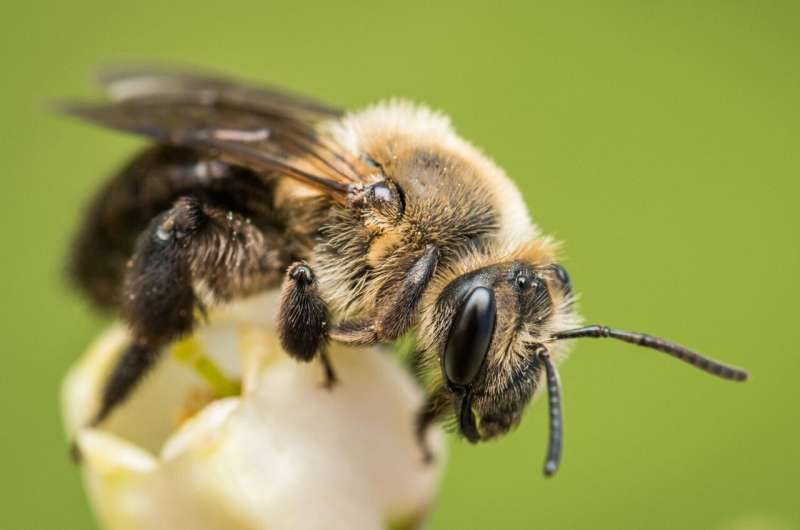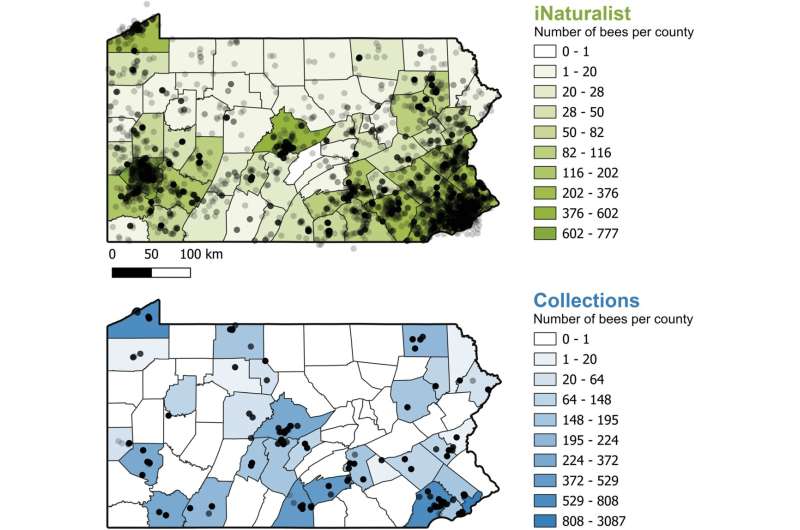This article has been reviewed according to Science X's editorial process and policies. Editors have highlighted the following attributes while ensuring the content's credibility:
fact-checked
trusted source
proofread
Volunteers record bee biodiversity and discover new species in Pennsylvania

Community scientists in Pennsylvania have reported multiple new species of bees never before found in the commonwealth through a monitoring program led by Penn State.
The program, in which highly trained participants collected bees throughout Pennsylvania, was designed to document regional patterns of bee biodiversity and their abundance as the critically important pollinators are in decline nationwide.
A study, published in the Annals of the Entomological Society of America, evaluated the efficacy of the program, finding that 26 trained program volunteers were more than twice as effective at documenting bee diversity than thousands of users of the photo-based app iNaturalist.
"This study demonstrates the value of involving highly trained community scientists in collections-based research," said Margarita López-Uribe, the Lorenzo Langstroth Early Career Associate Professor of Entomology and extension specialist of pollinator health at Penn State.
"It also revealed some of the limitations of photography-based monitoring, which is still a useful tool for scientists, but doesn't capture the full picture of biodiversity."
The researchers recruited 26 participants, mostly Master Gardeners, from across Pennsylvania to sample bees after receiving extensive training from Penn State experts. Between August 2021 and December 2022, the participants collected 9,062 bees, which were identified to species, stored in museum collections and the data were added to public databases.
During the same time period, 2,233 people on the photo-based app iNaturalist collected data on bees in Pennsylvania, resulting in 6,809 observations in which at least two people agreed on the type of bee pictured.
In comparing the data collected by Master Gardeners with data from iNaturalist, the researchers found that the trained participants documented over twice as much biodiversity and novel baseline natural history data as the iNaturalist users.
The Master Gardeners found 235 bee species, which was two and a half times more than iNaturalist users, at 92 species. Their data also resulted in 662 county records, meaning a new species was reported for the county, and seven state records; bees that had never been recorded in Pennsylvania. The iNaturalist data resulted in 321 county records and two state records.

The iNaturalist data covered a larger geographic range than data collected by the 26 participants, but in the end, the researchers determined that that collections-based approach of the program produced more reliable data with fewer biases against certain taxa than the photo-based approach.
"More than 80% of flowering plants rely on pollinators like bees to reproduce," Pennsylvania Agriculture Secretary Russell Redding said.
"Apples, peaches, berries, pumpkins, grapes and many other high-value Pennsylvania crops depend on bees, as does our $4.1 billion nursery and landscaping industry. In so many of our communities, our jobs and livelihoods revolve around producing foods that rely on pollination. The data in this report illustrate the value of citizen science in making sure we can protect pollinators and produce food in the future."
One of the biggest takeaways from the study, the researchers explained, is it demonstrates the value of establishing meaningful partnerships with local communities.
To monitor bees across the state of Pennsylvania at scale, the researchers relied on strong collaboration with the Master Gardener Program, which is coordinated by Penn State Extension.
Master Gardeners are volunteers who receive basic training in a broad range of horticultural topics. They serve as ambassadors in their communities, sharing best practices based on university research and engaging those around them in the issues that affect the environment.
"This project showcases how Pennsylvanians are engaging in community science to serve their communities and the commonwealth," said Nash Turley, a postdoctoral scholar at Penn State and lead author on the study.
"The effectiveness of this collaboration suggests it could serve as a model for other programs to further develop volunteer-based opportunities and contribute to future efforts to better understand and protect our state's biodiversity."
Other Penn State co-authors on the paper are Sarah Kania, Isabella Petitta, David Biddinger, Thomas Butzler and Valerie V Sesler. Elizabeth Otruba of Drexel University is also an author on the paper.
More information: Nash E Turley et al, Bee monitoring by community scientists: comparing a collections-based program with iNaturalist, Annals of the Entomological Society of America (2024). DOI: 10.1093/aesa/saae014
Provided by Pennsylvania State University



















